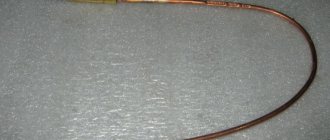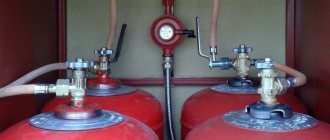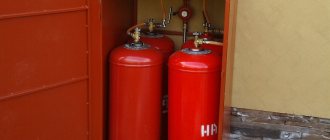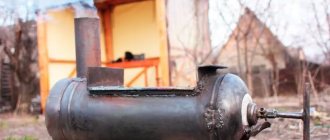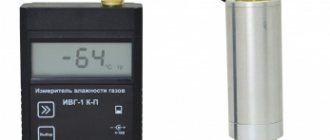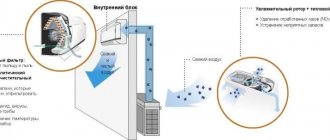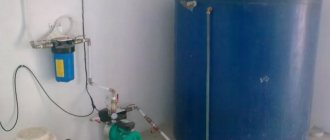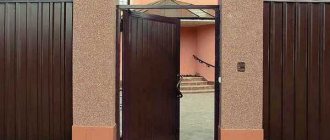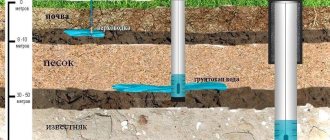A stable gas supply is ensured by the pressure in the propane cylinder. Such containers are used for cooking stoves, as automobile fuel, and even as an energy carrier for gas heating boilers, although the latter option requires some technical intervention in the nozzle system. Be that as it may, this type of liquefied fuel is extremely popular and is supplied in tanks with a capacity of 5, 12, 27 and 50 liters, although this does not mean that they are filled to capacity. Below we will look at what pressure in a gas cylinder is necessary for stable operation, tools for checking pressure, and rules for storing propane tanks.
Household propane reducer - key criteria for the right choice
As is known, liquefied hydrocarbon gas (propane-butane) is stored in cylinders or gas tanks under a pressure of several bar. To reach the operating parameters of consumers (30-50 mbar), a special device is used in autonomous gas supply systems for private facilities - household propane reducer. If we draw an analogy with an electrical network, this device acts as a stabilizer, that is, it reduces the pressure to the required value and automatically maintains it at the same level.
Useful tips for using cylinders
During cold periods, it is better to warm the cylinders before using them outside. On a hike, you can take it in your sleeping bag or keep it in your bosom for a couple of hours. In everyday life, it is enough to simply store the product in a heated room. Of course, as far as possible from heat sources and open flames.
If you intend to fly by plane or travel by train, it is better to choose collet cylinders. They are the safest and will not cause unnecessary questions or problems. If the burner is intended for threaded connection, you can prepare a special adapter in advance.
Be sure to pay attention to the proportions of the gas mixture in the cylinder, focusing on weather conditions. In addition, we recommend buying only high-quality gas from well-known manufacturers, avoiding low-quality Chinese counterfeits.
Read also: Message about brass in chemistry
Both among people who carry out repairs professionally and among home craftsmen, a manual gas burner with a cylinder is very popular. The scope of their application is very wide, there are several varieties. This article tells you how to choose the right gas burner for a cylinder and learn how to use this device, which is not the most intricate design, but extremely useful in many cases when a room is being renovated.
Design and principle of operation of the gas reducer.
Any propane reducer contains the following components:
- valve;
- working chamber;
- locking spring;
- compression spring;
- membrane
The throughput of this device depends on the degree of opening of the valve, which is influenced on one side by a membrane and a pressure spring, and on the other by gas and a shut-off spring. The higher the propane pressure in the cylinder and the lower the flow rate of gas-using equipment, the closer the valve is located to the seat. Conversely, as the pressure in the chamber drops and the flow rate increases, the valve opens more. The operating parameters of a household propane reducer are determined by the stiffness of the springs and the elasticity of the membrane. Some models are additionally equipped with a valve, the shaft of which is connected to a pressure spring, which allows you to manually regulate the gas supply within a certain range.
Operating principle of the device:
Modern propane reducers are sometimes additionally equipped with a safety mechanism that is triggered if the inlet pressure of propane-butane is exceeded. In order to increase the level of safety, such reducers are usually installed on gas tanks and group cylinder installations used for gasification of one or several houses. You can learn more about how autonomous heating is implemented in private households from the article: Autonomous heating with propane butane.
Sequence of installation and use
A propane reducer of any type and design is considered a high-risk technique, therefore, when installing it, a number of mandatory requirements must be observed:
- The room (if the gearbox is mounted to an internal consumer) is thoroughly ventilated. Moreover, the window/vent must remain open throughout the entire duration of the initial start-up.
- The correct sequence for using the device is as follows: first, the valve on the propane cylinder opens smoothly. Then the valve of the reducer opens and only then the valve of the gas-consuming equipment. By rotating the adjusting screw handwheel, the required level of operating pressure is set. Disabling is done in reverse order. When extraneous sounds appear - clicks, hissing, etc. - the equipment is immediately turned off.
- After establishing a stable flow of gas through the reducer, monitor the readings of the pressure gauge needle, which should not deviate more than the pressure fluctuation values indicated in the passport. Otherwise, the use of the technology is stopped. A slow increase in gas pressure is considered especially dangerous.
- Once every 2...3 months, the tightness of all connections is checked, and if necessary, the threaded fasteners are tightened.
- If routine maintenance of the propane reducer is necessary - purge the valve - the device is disconnected from the gas main, after which the remaining gas is released from all working cavities of the device. All subsequent operations are performed only in special workshops that have test benches.
- After finishing use, the inlet valve on the gearbox is closed all the way. In this case, the binding of the spring is eliminated, and its performance increases.
- To comply with fire safety rules, it is advisable to provide flame extinguishing devices between the gearbox and the gas-consuming installation.
How to choose a household propane reducer
The choice of a device for supplying a propane-butane mixture to gas-using equipment is based on two key parameters:
Sample passport for a gas stove
The operating mode of most household propane appliances is 30 mbar, 37 mbar or 50 mbar. Based on this indicator, the appropriate gearbox is selected. If its output pressure differs from the operating parameter of a gas stove, boiler or, for example, a grill, this may lead to improper operation of the equipment and even create an explosive situation.
The characteristics of the propane reducer can be seen on it - 3 kg/h and 29mbar
30 mbar, 1.5 kg/h (kg/h)
For stable and safe operation of the gas consumer, it is also important that its consumption does not exceed the performance of the gas reducer. In this case, the upper level of gearbox consumption is not standardized. That is, for a boiler with a power of 24 kW with a mass flow of 2 - 2.5 kg/h, it is permissible to install a gearbox with a capacity of 3 kg/h and higher - the automatic boiler or stove will still not allow “extra” gas to pass through.
0.45 m3 (for propane - butane)
1000 Pa - 1 kPa - 10 mbar
30 mbar - 0.03 bar
Some owners of autonomous gas supply systems make the mistake of purchasing industrial gearboxes instead of household ones, considering them more reliable. Firstly, such devices are an order of magnitude more expensive, and secondly, they are designed to work with more powerful gas equipment, so they are not always compatible with household appliances.
You should also pay attention to the type of thread of the device. Gearboxes designed to work with non-flammable gases are equipped with a right-hand thread, and with flammable gases they have a left-hand thread and a mark on the nut.
Rules for installation and operation of a gas reducer
To connect a propane reducer to gas-using equipment, two methods are used: using a herringbone fitting or using a threaded connection. The first option is considered the simplest and is often used to connect the cylinder to a gas stove. The second method is more reliable and aesthetic, in addition, it allows you to connect one propane tank to several consumers at once.
Connection via fitting
Whatever option is chosen, during the process of connecting the gas reducer and starting the system, you must adhere to the following instructions:
- Make sure there are no cracks or depressions on the housing, check the integrity of the pressure gauge (if equipped).
- Connect the device to the cylinder (gas holder). For better tightness of the threaded connection, you should additionally use flax or FUM tape.
- Connect the gas line to the outlet pipe of the reducer. When using a herringbone fitting, secure the pipe at the mounting location with a clamp.
- Slowly open the cylinder valve, then turn the tap on the gas consumer.
It is worth noting that the device is intended for use in temperate climates, so its use is permissible at temperatures from -15 to 45 degrees Celsius.
An example of connecting a propane reducer in a group cylinder installation
A high-quality household propane stabilizer can last for more than one year without major repairs. Only rubber materials that lose their elasticity over time are subject to periodic replacement. You should also inspect the bypass valve 1-2 times a year and, if necessary, clean it. The degree of clogging of the gas reducer directly depends on the purity of the propane-butane mixture used. For example, here you can familiarize yourself with the standard forms of delivery of this high-purity mixture in accordance with GOST. If you use high-quality gas, the service life of shut-off and control valves and gas-using equipment will significantly increase, and the likelihood of sudden failures of the autonomous gas supply system will be minimized.
How much does a 5, 12, 27, 50 liter propane cylinder cost?
The price depends on the specific area in which the customer lives. How much an empty propane cylinder costs in our region, as well as the cost of refilling, is shown in the following table:
| Cylinder volume (liters) | 5 | 12 | 27 | 50 |
| Estimated cost of an empty new cylinder | 1080 | 1380 | 1500 | 2250 |
| Cost of refilled propane | 1155 | 1560 | 1905 | 3000 |
*prices are indicative depending on the manufacturer
The price of a cylinder is sometimes several times higher than the cost of the contents. But repeated refilling allows the tanks to be used for many years and even decades.
Source
How to convert a gas stove to bottled gas
In general, setting up a gas stove for bottled gas is not difficult; to properly adapt the stove you just need to change the gas supply nozzles to the burners. This can be easily done with your own hands without hiring specialists.
Gas is supplied to the burner using a special hole in the nozzle, which is an integral part of any gas stove. The hole can be of different diameters, depending on the pressure in the gas supply system. Of course, the pressure in the central gas lines is noticeably higher than in a conventional gas cylinder, and accordingly the diameter of the hole in the nozzle should be smaller.
Often, complete with a gas stove, the manufacturer also includes a set of jets designed for different types of gas mixtures - natural gas, propane-butane, etc. But if they weren’t there or the stove was bought a long time ago, it’s okay, you can buy the necessary jets in the store.
Choosing a jet for bottled gas
Jets (other names: nozzles, injectors, nozzles, etc.) for gas stoves are not in short supply; they can be bought at specialized retail outlets - markets, shops. In appearance, the nozzle is similar to a regular bolt with a thread applied, but unlike the latter, it has a hole in the center through which the gas actually passes. As we said earlier, the hole can be of different diameters, and usually its value is stamped on the end of the product.
Before buying a jet, you should determine what diameter is needed. This is an important point, since incorrectly selected jets will not allow the stove to work normally, or even make it impossible.
It is not difficult to understand that the stove is working correctly after replacing the jets:
the flame should burn without hissing, without yellow impurities and red tongues;
When lighting the burner, no popping noises are allowed, and the flame should not suddenly go out.
The required diameter of the nozzle hole is indicated in the instructions for the gas stove; if the instructions are lost, then information about your stove and its manual can be easily found on the Internet.
We categorically do not recommend changing the diameter of the nozzle hole yourself by caulking or drilling - new nozzles are not expensive, and “reworking” at home can have a detrimental effect on the operation of the stove.
What tools are needed?
To configure a gas stove for bottled gas and then connect it to a gas container, you will need the following tools:
first of all, new jets;
7 mm wrenches, wrenches or open-end wrenches;
a new flexible hose, 1.5 meters or more in length. Serves to connect the stove to a gas cylinder;
seal and gas reducer with outlet pressure 30 mBar.
Medium or low gas pressure. Which is better for the home?
In this article I want to talk about the difference in gas supply to a private home with medium and low pressure gas.
More and more often, cottage buildings in our country are gasified with a network of medium pressure gas pipelines (about 0.1-0.3 MPa, as a rule), rather than low pressure (150-300 mm per station). On the one hand, this is additional equipment (pressure regulator), and the gas pressure is higher, but on the other hand, considering how powerful gas boilers people install at home these days, medium pressure is the only way to supply gas in sufficient quantities to the end user.
When gasifying with low pressure, the pressure at the final device (for example, at the descent to the boiler), as it moves away from the gas distribution center (gas control point - a kind of local gas distribution center, in simple terms) will decrease. For example: if in winter the maximum possible pressure (low) at the outlet of the hydraulic fracturing unit is 300 mm. V. Art. (but again, this is the maximum permissible, as a rule, it is set in exceptional cases, in very problem areas), then with a gradual distance from the hydraulic fracturing, the user will have lower and lower pressure during the heating period, and according to our standards, even less than 120 is allowed mm. V. Art. Until severe frosts begin, there is usually enough pressure in the gas pipe for everyone. But as soon as the frost hits and everyone turns on their gas boilers at full power, the owners of cottages on the outskirts, at the most remote points from the gas distribution center (distribution center) - the gas pressure drops and drops. And when the pressure drops below the 120 mm bar. V. Art. Such happy owners of boilers, especially powerful ones, begin to have the following problems: the boiler either begins to go out periodically (not so bad, usually boilers with automatic ignition these days), or they get an error that there is no gas and do not turn on until the error is cleared.
When supplying subscribers with medium pressure gas, natural gas compressed to 0.1-0.3 MPa is supplied through a pipe to the house, again, the further from the hydraulic fracturing station, the lower the pressure, BUT! This gas pressure is only up to the personal pressure regulator installed at the inlet. Then the regulator reduces the pressure to low (approximately 200 mm Hg) and your boiler operates successfully without suffering from a lack of gas pressure. But this has its drawbacks. In Belarus, for the population, according to technical conditions, 2 types of regulators are included in the project: One regulator is GDGD 2.0, which is produced by Belgaztekhnika (the official description of it can be seen here) and the other regulator is ALSI FE-10 produced (its description can be seen here ). Their price is about 80 US dollars. Currently, as far as I know, they do not provide specifications for the installation of other regulators on the territory of the Republic of Belarus. So we have to choose the lesser of two evils (in the sense of regulators). But the advantages and disadvantages of each of these two regulators are in the following articles. But if there is a choice between what pressure gas pipeline to connect to the house, the choice in my opinion is obvious.
Source
We change the jets and connect the stove to the cylinder
Before starting work, the stove should be disconnected from the gas (if it is connected). Next, remove the burners; some stove models require removal of the top cover. After that, use a hex wrench to unscrew the old jet, and taking into account the size of the burner, immediately screw in a new one, and so on with all the burners.
The jets in the oven are changed in the same way as the burners - we remove the surfaces covering the burners, remove the burners and change the jets. For a more competent change, it is better to use the instructions for your stove.
What to look for when buying
When buying a new cylinder in a store, check its passport, which indicates compliance with GOST and TU, information about the manufacturer, empty and full weight of the tank, certification. This information is duplicated on the tank body closer to the valve. The data is stamped on the cylinder itself or on an attached plate.
When receiving a used cylinder during an exchange, make sure that there are no dents on it. Be sure to check the date of the next technical inspection. If it is expired, ask for another cylinder.
Connecting the plate to the cylinder
For this operation, you need to screw a fitting onto the gas stove pipe, and put a previously stored flexible gas hose on it and secure it with a worm-type clamp.
We attach the second end of the hose to the reducer and also tighten it with a clamp, and connect the reducer directly to the liquefied gas cylinder using paronite gaskets. Fastening is carried out using an open-end wrench; we place the gearbox in a horizontal position - this is important!
If everything is done correctly, there should be no gas leaks, but it is better to check this personally. To do this, use the simplest method - applying a soap solution to the joints. If there is a leak, it can be easily seen by the inflating soap bubbles. In this case, it is necessary to change the gaskets, tighten the clamps, and if there is damage to the hose, replace it.
Vessel capacity and gas flow
Steel cylinders come with a capacity from 5 to 50 liters. Composite ones hold from 5 to 47 liters. The larger the tank, the less often you will have to refill it and the gas will last longer. But with increasing capacity, external dimensions and weight also increase.
For heaters, 27-liter propane cylinders are often chosen, which are installed inside the housing. Welders use cylinders of 47 and 50 liters in order to less often take time off from work to change vessels. For camping and picnics you need light and compact 5 liter tanks.
The gas consumption in the cylinder depends on the characteristics of the consuming equipment and the frequency of use. For example, for a powerful heater with a consumption of 1 kg/h, a 27 liter cylinder will be enough for 13 hours of continuous operation, since the gas in a 27 liter cylinder is about 23 liters, and its density of 0.556 kg/l, multiplied by the volume, gives a mass of almost 13 kg of gas. But for food preparation, a 50 liter cylinder can be enough for the whole summer.
How to choose a reducer for a gas cylinder?
Why do you need a reducer for a gas cylinder? The easiest way to answer the question is by comparing a household reducer for a gas cylinder with a mains voltage regulator. For a thrifty owner, the use of an electrical stabilizer has long become the norm. A gas reducer for a cylinder is used for exactly the same purpose - to stabilize the pressure coming from the gas cylinder to our household appliances.
Reducing gas pressure to operating parameters that ensure stable operation of the equipment - this is the main task performed by a cylinder pressure reducing device. The characteristics of the inlet pressure are important for household appliances where the energy source is blue fuel.
It would seem that after we have found out why a cylinder reducer for propane and butane is needed, we can finish the article, say goodbye to the readers, and submit the work for publication. However, not everything is so simple, and it turns out that the gas reducer operates according to completely two different operating principles and is divided into two types of devices.
What to do and where to turn if you fall?
Consumer rights are protected by the Law of the Russian Federation, and gas supply is no exception. Decrees of the Government of the Russian Federation dated July 21, 2008 No. 549 and No. 354 dated May 6, 2011 clearly regulate the procedure for supplying gas for the needs of citizens. Gas pressure is recognized as a parameter that service organizations are required to provide (you can learn more about servicing gas equipment here).
A prolonged drop in pressure below the established permissible norm is considered to be the provision of a utility service of inadequate quality. In this case, the citizen must report the incident to the emergency dispatch service of the gas supply organization.
Notice of violation may be submitted in writing or by telephone. When making an oral request, the dispatcher must register it and provide the registration number and time of registration to the applicant, as well as state his last name. In turn, the applicant must indicate his full name, residential address and the essence of the claim.
If the gas pressure is below the norm, then the consumer has the right to demand a recalculation of the payment for utility services (read about how to calculate the payment for gas according to standards and according to the meter in 2022). The monthly fee is reduced by 0.1% for each hour of supply of gas of inadequate quality (if the drop is less than 25% of the permissible norm). If the pressure decreases by more than 25%, no fee is paid at all until the violation is corrected.
Gas supply to apartments and private houses is fully subject to the established rules for the provision of utility services. Gas pressure is recognized as the main parameter determining the quality of service. The legislation of the Russian Federation strictly regulates its value and permissible deviations. A reduction in pressure above the standard gives consumers the right to demand elimination of the violation, recalculation of utility bills and compensation for damage.
Source
How does a cylinder reducer work:
1 Direct gearbox
An ordinary simple gas pressure reducing device consists of two chambers with an area of high and low pressure, separated by a rubber membrane. In addition, the “reducer” is equipped with an inlet and outlet fitting. Modern devices are designed in such a way that the bellows connection is screwed directly into the gearbox. Increasingly, you can find a gas reducer with a third fitting intended for mounting the monomer.
After gas is supplied through the hose and then through the fitting, it enters the chamber. The created gas pressure tends to open the valve. On the reverse side, a shut-off spring presses on the valve, returning it back to a special seat, popularly called a “saddle.” Returning to its place, the valve prevents the uncontrolled flow of high-pressure gas from the cylinder.
Membrane
The second acting force inside the gearbox is a rubber membrane that divides the device into high and low pressure areas. The membrane acts as an “assistant” to high pressure and, in turn, tends to lift the valve from the seat, opening the passage. Thus, the membrane is between two opposing forces. One surface is pressed by a pressure spring (not to be confused with the return spring of the valve), which wants to open the valve, on the other hand, the gas that has already passed into the low pressure zone presses on it.
The compression spring has manual adjustment of the pressure applied to the valve. We advise you to buy a gas reducer with a seat for a pressure gauge, this way it will be easier for you to adjust the spring pressure to the desired output pressure values.
As the gas leaves the reducer to the source of consumption, the pressure in the working space chamber decreases, allowing the pressure spring to straighten. She then begins to push the valve out of the seat, again allowing the device to be filled with gas. Accordingly, the pressure creeps up, pressing on the membrane and reducing the size of the pressure spring. The valve moves back into the seat, narrowing the gap, reducing the gas filling of the reducer. The process is then repeated until the pressure equalizes to the set value.
It should be recognized that gearboxes for direct type gas cylinders, due to their complex design, are not in high demand; reverse type gearboxes are much more widespread; by the way, they are considered devices with a high degree of safety.
2 Reverse gearbox
The operation of the device consists of the opposite action described above. Liquefied blue fuel is supplied to a chamber where high pressure is created. The bottled gas accumulates and prevents the valve from opening. To ensure gas flow into the household appliance, you need to turn the regulator in the direction of the right-hand thread.
On the back of the regulator handle there is a long screw, which, when screwed, presses on the pressure spring. As it contracts, it begins to bend the elastic membrane to the upper position. Thus, the transfer disk, through the rod, exerts pressure on the return spring. The valve begins to move and begins to open slightly, increasing the gap. Blue fuel rushes into the gap and fills the working chamber with low pressure.
In the working chamber, in the gas hose and in the cylinder, the pressure begins to increase. Under the influence of pressure, the membrane is straightened, assisted in this by a constantly compressed spring. As a result of mechanical interactions, the transfer disk lowers, weakening the return spring, which tends to return the valve to its seat. By closing the gap, the flow of gas from the cylinder into the working chamber is naturally limited. Then, with a decrease in pressure in the bellows liner, the reverse process starts.
In a word, as a result of checks and balances, the swing can be balanced and the gas reducer automatically maintains balanced pressure, without sudden jumps and drops.
Optimal gas pressure in the gas pipeline for an apartment and a country house
Each main gas pipeline has a certain pressure.
It depends on the type of end user and the characteristics of the system. Depending on the parameters of a particular network, they are designed to supply gas to different users. There are special standards for apartments and residential buildings. Compliance with them is necessary for the correct operation of all devices and ensuring a decent level of security. Special devices have been developed, the use of which allows you to stabilize the pressure before supply. To provide all users with “volatile” fuel, an extensive network of gas pipelines is required. In accordance with the safety standards set out in SNiP 42-01-2002, different sections of the network require different pressures. Depending on the purpose, there are 4 categories of gas pipelines:
- 1. A gas main, which is used to transport large quantities of fuel to a distribution station. Working pressure ranges from 12 to 6 atmospheres. Provides entire groups of consumers or specific resource-intensive areas of the technological process.
- 2. Lines with parameters from 6 to 3 atmospheres. Perform the functions of main distribution and supply of boiler equipment.
- 3. Medium pressure networks with characteristics from 3 to 0.05 atmospheres. They supply fuel to enterprises and heating stations.
- 4. Pipeline with low pressure not exceeding 0.05 atmospheres. Through them, gas reaches residential buildings and apartments of household users.
In case of certain malfunctions, the system is not able to supply gas at the required pressure. For a household user, this can lead to improper operation of the heating equipment and the risk of an accident.
For the proper functioning of all systems in an apartment or private house, a pressure of 0.05 atmospheres is required. In accordance with GOST requirements, a slight deviation is allowed, no more than 0.005 kilograms per square centimeter. Normalization of gas pressure is achieved through the use of special stations. The installations receive “blue” fuel from the main networks, reduce the indicators to the optimal 0.05 atmospheres, and then supply it to end consumers.
Insufficient gas pressure in the system causes discomfort in apartment buildings. The large number of consumers makes it necessary to ensure the most efficient use of natural resources. In winter, the consumption of “volatile” fuel necessary for heating residential premises increases.
In private homes, problems arise due to the high demands of heating equipment. Modern boilers are designed for certain pascal values in the pipes. If they are deficient, the device operates with various interruptions or fails altogether. In winter, this situation has dire consequences. In this case, choose heaters with a combined system that can operate on solid heat sources.
Insufficient supply of blue fuel causes great harm to the economic security of the state. Due to a decrease in combustion efficiency, efficiency losses reach 20 percent.
Gas pressure in the pipe above normal is very dangerous, as it often causes a major accident and the death of a significant number of people. To avoid problems with interruptions in gas supply, special distribution systems are installed in modern houses that maintain the most favorable pressure indicators in pipes in different climatic zones.
Low gas pressure in the gas pipeline will not ensure proper operation of the heater or heating boiler. Most often, the reasons lie in a malfunction of the backbone network or disruption of the distribution station. Pipes made from cheap metals are susceptible to corrosion. Leaks may occur in problem areas, leading to reduced distillation efficiency. In winter, condensate forms in the gas pipeline at various sections, which freezes under the influence of low temperatures, thereby blocking the path for fuel.
The quality of the equipment installed at a particular consumer is of no small importance. Faulty devices and leaky connections cause large volumes of gas to be lost
Particular care is taken when carrying out any type of repair work in the immediate vicinity of fire-hazardous networks. Unscrupulous neighbors who unauthorizedly connect to the gas supply pipe will cause a deterioration in the quality of fuel supply
Only they can establish the current gas pressure in the system, detect and fix problems.
Source
Types of gas reducers
From the school course, the concept of non-flammable – inert gas – comes to mind. This broad group includes nitrogen, argon, helium, neon, etc. they do not support combustion and do not burn. It is widely used as a shielding gas during welding. On the other hand, there are flammable gases (butane, hydrogen, methane, propane, propylene, etc.), which either liquefy or compress and then move their cylinders. So, in order to prevent confusion, engineers, even at the production stage, suggested cutting versatile threads.
Security zones
If complexes or buildings are being erected that are not involved in any way in the activities of the gas filling station system, compliance with the security zone is certainly taken into account, the length of which depends on the type of protected structure. Its dimensions:
- outside – 2 m on each side, even in cramped conditions;
- from underground - 3 m from the delimiting gas pipeline;
- CNG filling stations and gas filling stations are limited to a closed circle with a radius of at least ten meters from the established boundaries of the complex of capital construction projects.
Standard distances are the standard distance from the gas pipeline to communications. Water mains, power lines, roads and railway tracks must be located at a certain distance, which is regulated by a reference table. The minimum horizontal clear distances are taken into account (they depend on the pressure of the gas pipeline) and other existing requirements - electrochemical protection, climatic features, the presence of electrical installation regulations and high-voltage lines, etc.
The distance from buildings and structures to the gas pipeline must strictly comply with the standards. Distance standards are regulated by the pressure of the supplied gas and the type of gas pipeline constructed. For overhead low pressure, only a security zone is required due to existing operating rules. If necessary, it should be reconstructed.
Nuances
An additional application requires maintaining distances from boiler rooms, as fire-hazardous structures for industrial purposes. Two pipes - only 4 meters away from a residential building. Windows and roofing require at least 0.2 meters, and to the door - 50 cm.
Distancing from warehouses can be regulated by the enterprise, but it should not be less than in SNiP 2.07.01-89 and SP 42.13330.2011. The same applies to laying at the bottom of the slope, which can be regulated by builders and the Russian Railways administration (sometimes the distance from the gas pipeline to the railway tracks is reduced, but less than the norm is not allowed, especially near the embankment).
LPG tanks are taken into account separately. There are several types of them. For example, according to their orientation in space, they are divided into vertical and horizontal, depending on their location - underground and above-ground LPG tanks, single-wall and double-wall LPG tanks - according to the degree of endurance of the structure. The volume, location and type of complex regulate the distances. The standard GPC has a maximum pressure value.
Regarding tank installations, the standards of SP 62.13330.2011 are taken into account, but in each specific case the minimum distance is taken into account depending on the characteristics of a particular gas tank. Underground ones are deepened by 0.6 m, and the light distance between them is 0.7 m. A gas flow metering point is a prerequisite when using such installations; mixing stations, if necessary, are installed at 10 meters
A gas flow metering point is a prerequisite when using such installations; mixing stations, if necessary, are installed 10 meters away
Underground ones go 0.6 m deep, and the light distance between them is 0.7 m. A gas flow metering point is a prerequisite when using such installations; mixing stations, if necessary, are installed at 10 meters.
The design of buildings of any kind should be carried out near a gas pipeline only with the knowledge of regulatory and supervisory organizations, which calculate the norm depending on the type of structure and the supplied pressure of valuable chemical raw materials and fuel.
Reducer for gas cylinder
Since we are choosing a reducer for a gas cylinder, we consider it necessary to touch upon the topic of the container itself. The technological process and widespread introduction of new innovative materials are bearing fruit. You can increasingly find new composite cylinders on the market, replacing the old generation. Modern models, unlike outdated predecessors, have less weight and offer a greater level of safety. The latest manufacturing technologies undergo multi-level testing; at testing sites, the composite cylinder is subjected to an explosion, but even after such tests you will not find small fragments.
Composite cylinders are not subject to internal corrosion, are lightweight and comfortable. However, they do not know how to supply gas evenly on their own. A filled cylinder, of course, produces more powerful pressure than a half-empty one. A gas regulator will come to the rescue; its task is to regulate the pressure at the outlet of the composite cylinder and maintain it at the required level throughout the entire period of use.
Gas pressure reducers that have passed European certification show good collaboration with composite cylinders. Let's highlight one of these devices: the household gas reducer A300i-A310i IGT. The positive aspects include the following characteristics of the product:
- the presence of a nut that can be tightened by hand;
- service life of the control membrane increased to 10 years;
- the design ensures maximum sealing of the connecting elements;
- the gas hose on a fitting without a thread is clamped with a clamp.
Despite the fact that the importance of the device in creating conditions for the safe operation of a stove or other device is difficult to overestimate, household reducers for gas cylinders are usually sold at an acceptable cost. Despite the fact that the price rarely exceeds 300-400 rubles, these devices can protect not only your home, but also your life from dangerous situations.
Choosing a gas pressure reducing device is not a complicated process, but you should know and take into account such details as:
- The name of the gas passing through the device;
- Characteristics of the cylinder;
- Dimensions, type of flexible gas supply;
- Required flow and outlet pressure;
- Connection method.
How is the gas supply system organized?
Its hierarchy is determined by the classes of elements of the gas transmission network associated with the pressure of the pumped natural gas.
Principles of gas pipeline network design
The first level gas pipelines include gas communications in which the pressure of natural gas is high or medium. To eliminate dead-end sections, gas pipelines are backed up - duplicating individual segments or ringing. The creation of a dead-end network is allowed only in small settlements.
Natural gas under high pressure passes through several successive stages where its pressure is reduced. The process of reducing pressure at gas control points occurs intermittently, at the outlet of them the pressure is constant. In urban areas, gas communications with medium and high pressure levels form a hydraulically connected common network.
The use of hydraulic fracturing makes it possible to supply consumers with gas of different pressures, even if they are located on the same street - gas pipelines of unequal pressures are placed in parallel.
Second-level gas pipelines provide low-pressure gas fuel supply to the majority of consumers. Such networks are mixed, with a predominance of dead-end segments. Only the main pipelines are subject to ringing.
A low-pressure gas pipeline should not cross large man-made (highways, railway tracks) or natural (lakes, rivers, ravines) barriers. Installation of such communications in industrial areas is not allowed.
Gas networks supplying fuel at low pressure cannot form a hydraulically connected system for a large population center. They are designed exclusively as local complexes fed by several hydraulic fracturing units.
In turn, connected to medium pressure networks, which in turn, by analogy, are connected to high pressure mains. The third level of network gas pipelines is used at consuming facilities - on the territories of enterprises, in residential and public buildings.
The pressure requirement for such networks is determined by their purpose and the performance characteristics of gas-using devices (installations). Redundancy (partial duplication) on gas communications of the third level is usually not performed.
Gas reducers for gas cylinder, price and types
Let's try to choose a reducer for gas cylinders, from those popular types that are in greatest demand among consumers. Let’s take a look at the gas appliance market and find out what the price for a gas reducer for a cylinder was at the end of 2017.
Household gas reducer RDSG for propane stabilization
The leading position in the market, and among consumers in the country, is occupied by the RDSG-1-1.2 “Frog” device with a threaded fastening. The RDSG-2 Baltika gearbox equipped with a threadless connection is not inferior in popularity. Both leaders represent the simplest design. As a result, they can offer the lowest possible cost. Specifications: — inlet pressure from 0.7 to 15.7 Bar; — the output pressure lies in the adjustment range from 30 to 32 mBar; — device weight 310 g; — permissible operation in the range from -30 to +45 ±3 °C; — gas throughput characteristic — 1.2 m3/hour. You can buy a gearbox RDSG 2-1.2 Baltika or RDSG 1-1.2 Frog for up to 350 rubles.
vote
Article rating
Decor
The design of a gas stove for a cylinder is nominal - there is no need to visit any authorities, the requirements are easy to fulfill. The first was announced - the distance to the cylinder is at least 0.5 meters. Second: there must be at least 2 meters to the main lines - water supply, sewerage, metal heating pipes. That's all.
There are two options for official registration:
- When you fill up a new cylinder at a municipal gas station (not for cars, but specifically for refueling household gas cylinders), the station employee will fill out the paperwork for you. You will need to provide the address (at least approximately) and explain where the stove is located and where the cylinder is located. Here you have to be careful, at least say that it is worth it according to the rules. Yes, the cylinder must be purchased at one of the Gorgaz stores and you will need the registration number of the car on which this cylinder will be transported.
Refill dispensers for gas cylinders
For many, a gas stove for a summer house under a cylinder has been standing for years even without such “design”. But in this case, you will refill the cylinder yourself, without using the services of municipal gas stations or exchange machines. Also, if it is necessary to repair or maintain the stove, or reconfigure it, you will need to somehow resolve the issue of design (usually there are no problems) or use the services privately.
Connection step by step
The procedure and diagram for connecting a gas stove to a cylinder is as follows.
- Install the ball valve. Usually it is attached approximately in the middle of the hose, since when placing it in front of the entrance to the slab, the equipment will need to be extended a significant distance from the wall. The process itself is as follows: you need to cut the hose in half and connect both parts to the tap, clamping them with clamps.
- Connect the plate and hose. To do this, it is usually provided with a union nut with a sealing gasket for tightness, the condition of which must first be inspected. After screwing on the nut, you need to tighten it with a wrench. To avoid stripping the thread, do not overtighten it.
- Screw the second end of the hose onto the gearbox and secure with a metal clamp. It is tightened tightly, but carefully so as not to overtighten or damage it.
- Install the reducer horizontally and connect it to the cylinder with a union nut. You should first check the presence and integrity of the sealing gasket. This will ensure a tight connection.
The assembly work has been completed, you can begin testing and putting the equipment into operation.
Choosing a place to install the cylinder
Before connecting the gas stove to the cylinder, you need to choose the place where the devices will be installed, since the distance between them must be at least 100 cm. Safety instructions require that there be a window in the room with connected gas equipment.
When using a shielded cylinder, the distance between it and the stove can be reduced to 50 cm.
- If the gas container will be in the same room as the kitchen appliance, it is advisable to place it in a metal cabinet or make a wooden mount.
- The cylinder may be located in the pantry located behind the kitchen wall. In this case, you will need to make a hole for the hose.
- The best option in terms of safety is to install the cylinder in a special metal box located outside and locked with a padlock.
Important! You can place a cylinder in an apartment only if the building has no more than 2 floors.
Precautionary measures
Household gas is very dangerous. The main threats posed by propane are:
To preserve the life and health of people and their property, precautions should be taken:
Rules for using gas
- Avoid proximity to open flames and heat sources.
- Avoid the presence of other flammable materials in the work area.
- Eliminate the presence of nitrates and perchlorates near gas equipment due to their chemical activity.
- Do not use the reducer for a propane cylinder if it is damaged or leaking.
Commissioning
In order to carry out installation work correctly, you should first connect the line to the plate (and secure it), and only then connect it to the cylinder . Upon completion of assembly, you need to carefully turn the valve and select the required pressure of the gas mixture at the outlet through the reducer. When the gas fills the hoses, all joints and connections should be thoroughly coated with soap foam to detect leaks. If air bubbles appear, the joints need to be tightened. If they are tightened too much and there are still bubbles, you need to check the condition of the installed gaskets and, if necessary, replace them. If no problems are found, you should open the tap in front of the stove and check the operation of the burners one by one.
Important! It is prohibited to use matches or any other source of fire to check for gas leaks.
When putting the stove into operation, you may find some shortcomings that can be easily fixed with your own hands.
- If all the burners smoke and burn in any color other than blue or greenish, you need to reduce the output pressure using a reducer.
- When only one or several burners are not working correctly, this means that the jets for them are incorrectly selected.
- If the burner goes out when the minimum flame is turned on, you need to adjust the low gas flow screw on the stove tap or slightly increase the pressure through the reducer.
Safety requirements
When connecting gas equipment, it is important to comply with safety requirements. This is the procedure for choosing the location of the cylinder, recommendations for hoses, as well as the availability of auxiliary accessories for installation, such as a reducer, shut-off valve, flow meter, etc. After the connection is made, you need to regularly inspect the connections, diagnose them for leaks, and also inspect the hose for damage, even minor ones.
Important! It is prohibited to independently change any factory parts used for connection, for example, drill holes in the jets to obtain the desired diameter. Such actions usually lead to explosive consequences.
If you smell gas while operating the stove, you need to turn off its supply, ventilate the room and inspect the equipment for leaks. If the problem is not identified or cannot be corrected, you must call the appropriate gas service. In this case, turning on the lights or using electrical appliances is prohibited.
So, to connect a gas stove to a cylinder, the best solution is to call specialists. If this is not feasible for any reason, you can set up the equipment yourself, but subject to mandatory and scrupulous compliance with safety precautions and the specified procedure. You can clearly see the connection procedure in the video.
Materials and tools required for work
When connecting a gas cylinder to the stove you will need:
- 2 clamps;
- a fitting with a spout to attach a hose and internal thread (must be included with the gas appliance);
- the stove is new or old, but in good condition;
- reducer with inlet pressure 30 mbar;
- gas cylinder made of metal-composite, polymer-composite or other special materials with a capacity of 5–50 liters;
- rubber or rubber-polymer connecting hose, which can maintain room temperature and does not heat above 30 degrees;
- sealing tape;
- special gas key.
Important! To connect a gas stove model, you must use only keys with brass or copper coating, which will not cause a spark if struck.
